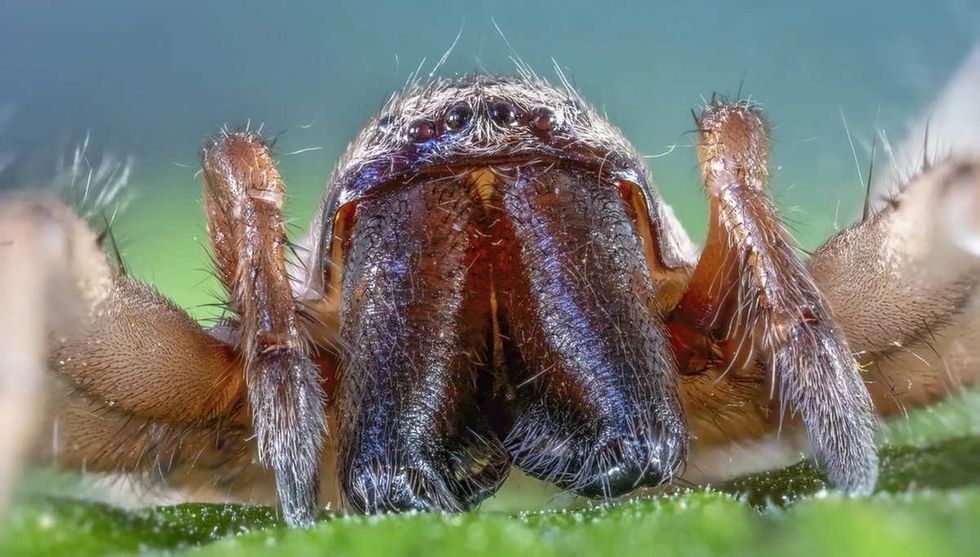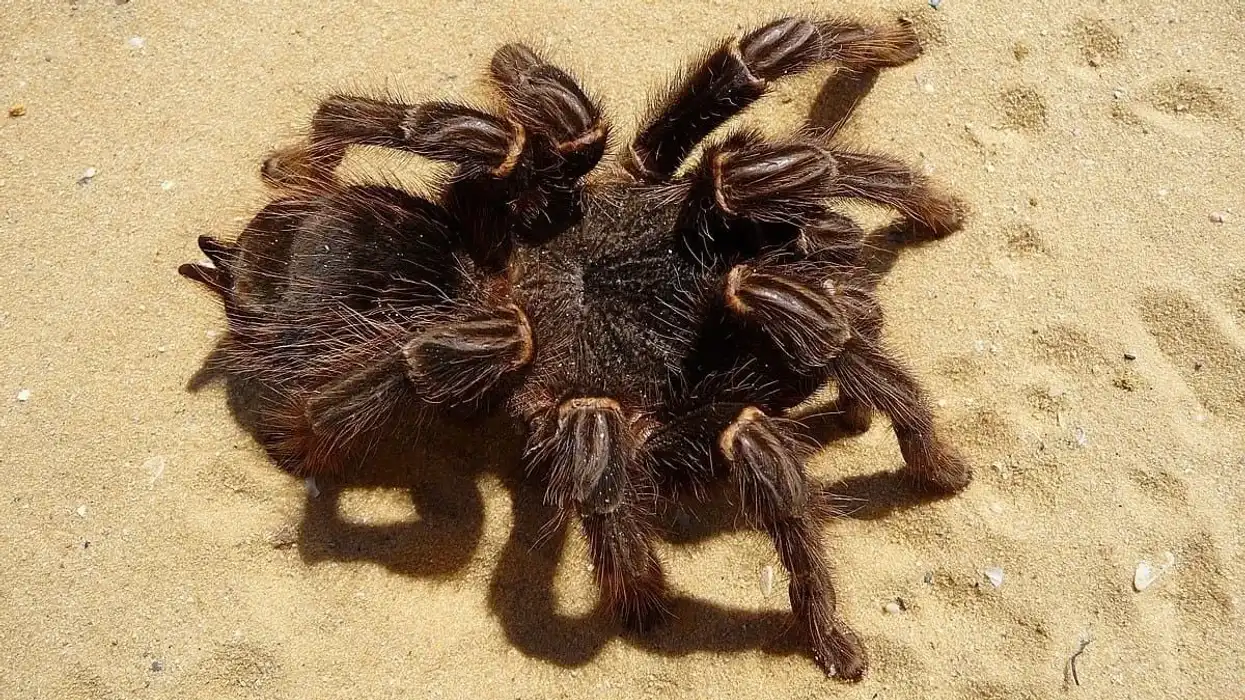The woodlouse spider (Dysdera crocata) is a type of common house spider which is named after its primary source of food, the woodlouse. This spider can usually be found in warm, damp habitats, mostly in rotting wood and leaves.
It has a number of different names, all based on variations of the common name of the woodlouse, these being slater, pillbug, sowbug.
This spider is known for its beautiful red color and distinct oval pattern of its eyes. This species uses its large, protruding fangs and sharp bite to entrap its prey. Despite bring venomous, it is not deadly to humans, its bite at most causes irritation and itching to the affected area.
To learn more about this unique spider, read on! You can also find more interesting facts on our southern house spider and banded garden spider pages.
Woodlouse Spider Interesting Facts
What type of animal is a woodlouse spider?
The woodlouse spider (Dysdera crocata) is a type of arachnid which is named after its primary food source, the woodlouse.
What class of animal does a woodlouse spider belong to?
The woodlouse hunter belongs to the class of Arachnida.
How many woodlouse spiders are there in the world?
There isn't an exact count on how many of these spiders exist in the world, however they are known to be one of the most common spiders spotted in America, so it is safe to assume that their numbers are pretty high.
Where does a woodlouse spider live?
Woodlouse spiders can be found living in and around any type of wood such as logs, old tree trunks, discarded furniture. They can also be found nesting under rocks, in bricks, old plants and inside houses where woodlice are prevalent.
They are known to make tent like structures out of their webs, akin to a silken retreat in hidden places, where they rest during the day.
What is a woodlouse spider's habitat?
They can be found all over the world, however in terms of habitat they prefer to make camp in damp, rotting wood, situated in warm places. This includes old logs, decaying tree trunks and tossed out furniture.
Who do woodlouse spider live with?
These spiders do not live live in packs as such, however they can be found living in high concentrations wherever there is the presence of woodlice. New mothers are known to live with and nurture their young for a brief period of time until they are ready to live on their own.
How long does a woodlouse spider live?
Woodlouse spiders can live up to three years of age.
How do they reproduce?
The mating process of woodlouse spiders is risky business, with a high chance of injury or death on either side. The presence of their large venomous fangs, which they use to pierce and trap prey, makes it quite difficult for them to mate without accidentally stabbing each other.
After the male mates with the female, it runs off to continue mating with other spiders, while the female lays an egg sac containing up to 70 eggs suspended from the threads of her retreat.
After a brief incubation period, the eggs hatch and the young spiders are taken care of by their mother for a while, until they are ready to leave the nest.
What is their conservation status?
The exact conservation status of this species is unknown according to the IUCN Red List, simply being listed as Not Evaluated. However, since they are commonly seen, it is safe to assume that they are under no threat of extinction at the moment.
Woodlouse Spider Fun Facts
What do woodlouse spider look like?
This red spider species can easily be identified due to its bright color. It has eight dark red-orange legs, along with a shiny gray or yellow abdomen.
Its main distinguishing feature is the presence of six eyes, which are arranged in an oval on its face. Males and females look the same, with the female being slightly bigger in size.
How cute are they?
These spiders actually have a very threatening appearance, which is worlds away from their shy, easily spooked demeanor. Their hard, shiny skin and six beady eyes make them look quite unappealing, prompting most people to stay away.
How do they communicate?
They communicate by releasing chemical signals from secretors on their torso. These signals are then picked up by other spiders, who can determine the moods relayed by the secretor. Females tend to release pheromones during the mating season which help to attract males.
How big is a woodlouse spider?
The woodlouse hunter species is not a very big spider. Females are slightly bigger, clocking in at around 0.43–0.59 in (11-15 mm), whereas the male is only 0.35–0.39 in (8.89-10 mm).
How fast can a woodlouse spider jump?
These spiders are known to jump very high when defending themselves from attackers. They are known to get into a threatening stance, baring their fangs on getting onto their back legs in order to spook the enemy.
How much does a woodlouse spider weigh?
The exact weight of the sowbug hunter species is unknown, however judging from their small size their weight ought to be very less.
What are the male and female names of the species?
There are no specific names for the males and females of these species, simply being known as spiders.
What would you call a baby woodlouse spider?
A baby hunter and slater spider is called as a hatchling or spiderling.
What do they eat?
True to its name, the woodlouse hunter feeds primarily on woodlice. However, it is also known to eat other insects such as earwigs, crickets, silverfish and beetles if woodlice aren't available in its natural habitat.
It is equipped with large, sharp fangs which protrude from its jaws, designed especially to pierce the hard shells of these bugs. Its bite has enough venom to stun or kill its prey.
Are they poisonous?
Woodlouse spiders are venomous, but their bite does not contain enough venom to cause damage to humans. Their venom is only adequate enough to shock and paralyze its prey. On the other hand, a woodlouse spider bite can be very painful, and the small amount of venom can cause irritation to the affected skin.
Would they make a good pet?
These spiders are not a very popular choice for a pet, however they can be kept in captivity if desired. They are shy and timid in nature, but if they feel threatened they may bite so it is not advisable to pick them up with ones bare hands.
They can be fed small insects such as woodlice, crickets and millipedes. They thrive best in their natural habitat, owing to the availability of old wood and abundant woodlice.
Did you know...
The woodlouse hunter is nocturnal, meaning it rests during the day and hunts at night.
This spider uses its webs only for constructing its tents, preferring to hunt its prey down using its long fangs and deadly bite.
The woodlouse hunter spider is actually very useful and is known as a farmers friend, as its helps to exterminate pesky woodlice which bore through wood.
It has various names which all allude to the differences in the common name given to its primary prey, the woodlouse. These include wood spider, woodlouse hunter, sowbug spider, slater hunter, sowbug killer, pillbug hunter and slater spider.
It is actually difficult to tell it apart from its woodlouse spider look alike cousin, the lesser woodlouse spider (Dysdera erythrina), which is smaller and lighter in color than the former.
Are woodlouse spiders common?
Slater spiders are known as the most common house spiders in America and in the UK, as they are usually found wherever woodlice are located. They are abundantly available in damp, woody areas such as forests, under rocks and even in houses where there are woodlice infestations, making them very easy to spot.
they have been around since a very long time, being spotted wherever woodlice infestations have occurred.
Here at Kidadl, we have carefully created lots of interesting family-friendly animal facts for everyone to discover! For more relatable content, check out these garden spider facts and nursery web spider facts for kids.
You can even occupy yourself at home by coloring in one of our free printable woodlouse spider coloring pages.










